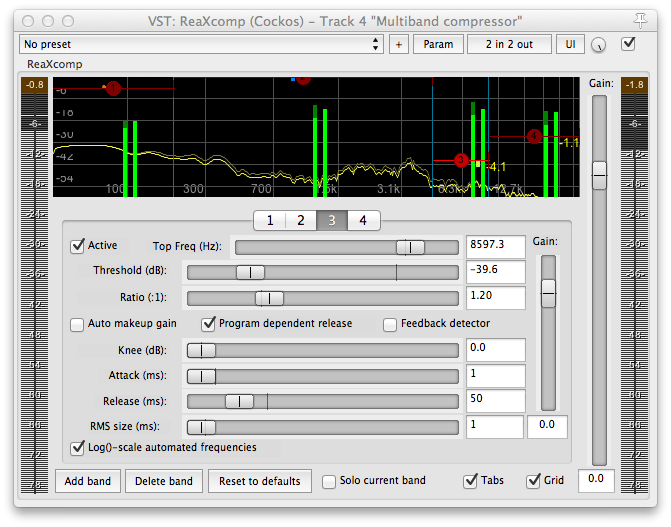I have a pretty good ear for sibilance but I don’t tend to use DeEssing much in my mixes. Maybe I’ve just been lucky lately and my clients know how to pick a good mic for vocals. I DeEss reverbs more often than lead vocals actually. There are a ton of ways to tackle this problem, so here are my top 4 ways to DeEss without using a DeEsser.
Source Audio
For all the examples I’ve used the same source. My friend Jordan’s demo of the MXL V67G with RK47 capsule upgrade. The capsule upgrade was a remarkable improvement but still quite sibilant on his voice.
1 – Manual volume adjustment
Zooming in, it’s usually easy to see an Ess in the waveform. By using the “clip gain” function (or a pre-FX volume control) you can trim the Esses down by 2-6dB. If you have compressed the voice heavily you may be surprised at how aggressive you need to be with these volume changes. In this example I’ve done no processing, just trimmed the level of the item down around at the Esses. Breaths have also been reduced. I use this technique most, even with a DeEsser plugin for extra control over clicks, breaths etc.

2 – Compressor Internal Sidechain
A lot of compressor plugins have the option of filtering the audio used to trigger the compression, a sidechain filter. In REAPER’s ReaComp I used the “preview filter” option to listen to the sidechain and isolate the sibilance. I then adjusted the compressor to react quickly to get about 4dB of GR.

3 – Compressor External Sidechain
Another way of doing this is using the compressor with an external sidechain source, from another track. In this case it’s a duplicate of the voice that has been EQ’d to accentuate the problem area. This filtered voice is sent to channels 3-4 of the main voice and it’s main output is disabled. In ReaComp the detector input is changed to auxiliary. This is a little more complicated to set up but is more flexible with the filtering options.

DeEssed voice
Sidechain signal
4 – Multiband Compressor
A multiband compressor can also be used to reduce sibilance. With this method only the high-mid/high frequencies are reduced, rather than the entire frequency range. I’ve used REAPER’s ReaXcomp with a few dB of gain reduction in band 3 and 4 only.

With all the techniques above, and with a dedicated de-esser, care must be taken to keep the sound natural. Too much gain reduction will make ith thound like a lithp and you really don’t want that.
[originally published on AudioGeekZine July 2013]


Comments
5 responses to “4 ways to DeEss a vocal (without a DeEsser)”
Eq automation on the spot of the Sss …ore volume decresse had some good results with that in the past
Great tips thanks
Nice post Jon. Thanks!
I tried A LOT of de-esser plugins but they always fall short. Currently the best way (though tedious) for me is to put the included “JS: Volume Adjustment” plugin, set the main parameter to an envelope and do all the de-essing there manually. The “add 4 points” action shortcut helps a lot on this task.
The good thing about this technique is the ammount of control on each sibilance, the possibility to adjust where the de-esser goes on the chain (I always de-esse after compressor) and it’s also easier to undo/disable.
5 – Dynamic EQ (like TDR Nova)